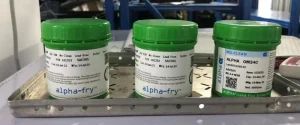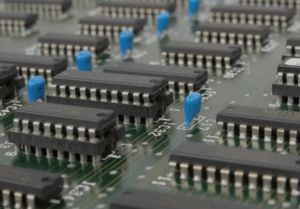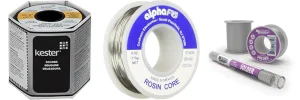Soldering on circuit boards is a tricky method. If you are a beginner, you might experience it. The most challenging part is determining the right time to melt the solder and attach it to the component. Low-quality soldering sometimes makes the process even messier. Therefore, choosing the best solder for electronics is a crucial topic to discuss.
The best solder for electronics can offer you strong and reliable connections on circuit boards. The right solder indeed ensures the quality, durability, and performance of your project. Therefore, understanding the types of solder and how to use them is the key to success.
This article typically explores the world of soldering. It begins with mentioning different types of solder used in electronics projects. It also advises you on how to select the best solder for electronics.
The perfect soldering is not just limited to choosing the best solder for circuit boards; it must be done correctly. At the end of this article, we will learn how to solder correctly on a circuit board.
Overview of Soldering in Circuitry
Soldering is a basic but essential skill in electronics. It mainly joins two or more metal parts using a melted filler metal called solder. On PCB, soldering typically joins the components in the designated position. Based on the different types of components and the PCB, the kind of soldering method differs.
Except for manufacturing, soldering is widely used in repairing and creating prototypes. There are various types of soldering methods. Hand soldering, wave soldering, and reflow soldering are some standard methods.
The hand-soldering method typically uses a soldering iron for the work. It is the most commonly used method for repairs and general-purpose circuit making. The wave soldering is generally used for the mass production of through-hole PCBs. On the other hand, reflow soldering is preferred for SMD (Surface Mount Devices).
If you are doing it by hand, you must learn how to do it correctly. Purchase a high-quality soldering iron and the best solder for circuit boards. You can also consider using resin, which removes oxides from the metal surface. It is necessary for the proper solder flow and adhesion. Resin is also known as soldering flux.
Types of Solder Used on Circuit Boards
There are various types of solder out there. Some are pure tin-lead solder, some are lead-free, and some are mixed. Some solders come in the form of wire, some come in paste, and others come in various forms. Therefore, we can categorize them into two main groups.
Based on Lead Presence
This category describes the various types of solder based on the presence of lead in their composition.
Lead is a metal that helps solder melt at a lower temperature. Most traditional solders have lead in their composition. However, lead is not safe for health and the environment. Therefore, many products require lead-free soldering for their PCBs.
Tin-Lead Solder (SnPb)
As the name suggests, this solder consists of two basic components: tin (Sn) and lead (Pb). The combination of these two elements creates an alloy. It is widely prevalent in joining metals in various projects.
The composition of the tin-lead alloy or solder may vary. It could be 60/40 (60% tin, 40% lead), 63/37 (63% tin, 37% lead), 50/50 (50% tin, 50% lead), or other ratios. The specific ratio typically affects the melting point and other properties.
Both tin and lead are conductive metals. However, the composition of both metals improves the conductivity.
Among these types, the 60/40 and 63/37 are the most common. 60/40 has a wide range of applications, while 63/37 is a eutectic alloy. Here, eutectic means it has a particular melting temperature. Such efficiency transforms it from a solid state into a liquid without any pasty phase, making it suitable for creating delicate items.
Lead-free Solder
As the name suggests, this type of solder composition doesn’t include lead. Since lead is not safe and poses various health risks, many applications typically restrict its use. Thus, the name is lead-free solder. It is also a type of metal alloy used to join electronics or other electrical applications.
Typically, lead-free solder uses tin (Sn) as the primary element. Additionally, it incorporates other components, including silver and copper, among others.
Common types of this solder include SAC305, which is a popular choice for circuit boards. Additionally, there are other types, such as tin-silver-copper (SnAgCu), tin-copper (SnCu), and tin-bismuth (SnBi). These alloys serve in specific applications.
Mixed / Alloy Solder
Mixed alloy solder is a type of solder that uses two or more elements to make the alloy. Elements vary depending on the purpose of each alloy and its requirements. As mentioned above, lead-free is an alloy that serves as an alternative to avoid health and environmental risks. The primary purpose of making it is to build strong joints between components.
Types of these alloys can be SAC (Tin-Silver-Copper), Tin-Antimony, Bismuth-Tin, and many more. Each one has unique properties and application needs. Therefore, ensure you have the correct alloy to make joints.
Based on Forms and Use
This category generally describes various forms of solder. The specific form typically comes from the manufacturing requirements. For example, soldering wire is better for hand soldering. On the other hand, solder paste is suitable for the SMD or wave soldering method.
Solder Wire
Solder wire is a thin and versatile option suitable for manual soldering work. It often contains a core of flux and chemicals that clean the metal surface. Here, the thickness varies with the purpose of the tasks. Commonly, it ranges from 0.8 mm to 1 mm and is used with a soldering iron.
Solder Paste
Solder paste is a mix of powdered solder and sticky flux. This pasty or gray, gooey substance helps connect electrical components in the circuit. You can apply it through a stencil or dispenser to ensure perfect alignment. Thereafter, you can take it to the reflow oven to further secure the connection.
Solder Bars
Solder bars are rectangular, solid blocks of solder alloy. Manufacturers mainly use it in large-scale production for wave soldering. In industrial applications, the solder bars are melted in a pot and turn into a molten wave. Then, it flows over the underside of the PCB and quickly does the work. It is a fast and efficient way, especially in mass production.
The Best Solder for PCB (Printed Circuit Boards): How to Choose?
Choosing the best solder for electronics needs some careful consideration. You must first know your project requirements. Whether your project requires lead-free soldering, you can decide on the right composition for it. Additionally, you must also consider how you will do it.
Moreover, are there any specific physical or electrical properties? Will it be used in medical applications? How about the shipping policy?
Lead and Lead-free Solder: Which is Better?
Soldering is a crucial step in creating electrical circuits. Lead and lead-based techniques are extremely popular worldwide. Choosing the best one depends on the type of application you have. Leaded solder may be preferred by hobbyists or for specific uses. Low melting temperature can be a reason for this.
On the other hand, lead-free soldering is widely used in industrial applications. Besides, it has relatively fewer health and environmental risks, which is a fundamental requirement in some countries.
Lead-based Solder
- Lead-based solder is typically a Tin-lead alloy, with a ratio of 60/40 or 63/37.
- The melting temperature of Tin-lead alloy is comparatively lower. As said, the melting point is around 361°F or 183°C.
- The alloy exhibits excellent wetting properties.
- Strength is considerable, but it can suffer from tin whiskers.
- There is a health risk associated with its use, and it does not comply with the RoHS directive.
Lead-free Solder
- Lead-free is a Tin-Silver-Copper alloy (commonly SAC)
- The melting point is higher (around 423°F or 217°C)
- Wetting properties are not that efficient
- The alloy is stronger and more resistant to tin whiskers
- There is no health risk, and it is also compliant with RoHS
The rest depends on your tasks and requirements. When selecting between these two solders, ensure that you choose the one that meets all your requirements.
Ease of use: Wire vs Paste vs Bars
Solder wire is the easiest way to do manual work and small-scale projects. You can easily use it for repairing or soldering single joints. Its thin shape plays a significant role, allowing you to control it precisely while soldering.
Solder paste is not as easy as solder wire. Therefore, it’s not suitable for hobbyists to do manual work. It is made for automated assembly. It requires a stencil and a specialized reflow oven. However, paste is easy for mass production.
Solder bars are the most complex to use for a single item. It requires large pots for molten solder and wave soldering machines. This makes it suitable for use in factory settings for bulk manufacturing.
Physical & Electrical Properties
In terms of lead solders, the physical properties are good. Due to the low melting and superior wetting properties, it easily flows and spreads. Also, lead solder features high electrical conductivity.
In contrast, the lead-free solders are not ductile and less conductive. As you are aware, the melting point is also higher and more prone to the formation of tin whiskers. Some essential physical qualities are a dull, crystalline finish and a wider freezing range.
Cost and Availability
Lead-based solders are less expensive because lead is a cheaper material. It’s also widely available. However, due to environmental regulations, its availability is limited in some regions. However, lead-free solders are readily available everywhere. The cost may seem higher, but the benefit is well worth it, as it is eco-friendly. Furthermore, it’s a standard choice for modern electronics.
Popular Best Solder for Electronics Projects
In the market, you can find a variety of brands and types of solder for electronics. Choosing the right one could be tricky. To generalize this process, we have gathered the three most popular and best solder for electronics in the market.
Note that if you cannot find these exact products in your market, you can choose other sellers with similar specifications or features. The key is to focus on quality and suitability for your project.
Kester 44 Rosin Core Solder
Kester 44 rosin core solder is a high-quality solder that is widely used in electronics. Typically, it is used to assemble electronic circuits. The rosin flux in its core instantly cleans the metal surface.
Prices may vary depending on the type of alloy, wire thickness, or spool size. 0.5 to 1 ounce may cost between $4-$15, and larger sizes can cost $30 to $100.
Alpha Fry AT-31604
This is also a rosin-core solder with a 60/40 tin-lead composition. Hobbyists primarily use it for general-purpose tasks, including soldering and repair. Prices for a 4-ounce spool usually range from $15 to $25.
MG Chemicals 63/37 No Clean Solder
It’s a well-known solder of 63/37 tin-lead composition. As it shows a eutectic feature, this makes it ideal for working with delicate circuits and electronics repairs. The residues it leaves do not need further cleaning. A small spool can cost between $5 and $10, while larger ones cost between $30 and over $60.
How to Solder Correctly on a Circuit Board
The perfect soldering is not just limited to choosing the best solder for circuit boards. Instead, you must do it correctly. The proper way of soldering requires careful attention, especially when melting the solder and attempting to join components on the PCB.
Sometimes, the solder doesn’t melt even after applying heat over time. Therefore, choosing the right tool and the solder materials is critical.
Choose the Right Soldering Tool
Using the right tool means having successful soldering. Select a soldering iron and use a sponge to clean the tip. Additionally, select a high-quality solder with a good cutter for it. These things will help you achieve the optimal outcome.
Choose the Best Electrical Solder
For circuit boards, you can use thin solder wire with a diameter ranging from 0.5 to 1 mm. Based on your requirements and regulations, you can use either lead or lead-free alloy. For beginners, 63/37 tin-lead alloy would be a great choice.
Consider using Soldering Flux or Resin.
Flux is a chemical agent used to clean, which is essential for good joints. It helps to make bonds properly by removing oxides and impurities from joints. In contrast, resin is a component of certain types of soldering flux itself. Select between these two soldering accordingly.
Prepare the PCB and Components
Before starting the soldering process, ensure that your board and components are clean and free from oil and dirt. In this step, you may use isopropyl alcohol and a small brush to clean them. Once all your equipment is properly cleaned, you can now proceed to the next step.
Heat the Joint Properly
Using the correct temperature is the most critical part here. Applying too low a temperature may prevent the solder from flowing properly. On the other hand, excessively high temperatures can cause damage to the components. Therefore, choose a temperature between 350°C and 375°C (662°F to 707°F) for better output.
Apply Solder Correctly (Tricky Part)
After about two or three seconds of heating, touch the solder wire to the joint. Don’t touch the iron tip. The hot joint might melt the solder, allowing it to flow to the pad and lead. Thereafter, remove the solder and then the iron tip. At this point, it will enable the joint to cool down without movement, preventing cold solder joints.
Inspect the Joint
A good solder must be shiny and smooth, looking like a small, volcano-shaped mound. So, inspect your solder. If the solder is fine and uniformly done, then it is okay. However, dull, lumpy joints can cause poor connections that may lead to failure. Then, apply more solder and reheat it to improve the connections.
Clean the Board
After inspection and cooling, if any residues remain, they must be cleaned. In this cleaning step, you can use a flux cleaner and a brush or cotton swab to remove any remaining flux residue. This step is more important for preventing corrosion over time. Additionally, it enhances the professional and clean appearance of your circuit board.
Expert Advice
Soldering is an essential skill in electronics, which typically joins components on a circuit board. In this case, the solder material plays a crucial role. Now, here comes the challenge.
In reality, various types of projects have different requirements. Some products must be safe for people, while others require cheaper and durable solutions. This diversity typically brings different kinds of solder. Here, selecting the best solder for electronics is crucial.
You can select the correct type of solder based on your project needs. Lead-free soldering is safer, while lead-soldering is easy to use. They both have their unique pros and cons. Solder also comes in various forms, including wire, paste, and bars. The choice mainly depends on your production method.
During soldering, it is also essential to follow the proper SOP. If you are a beginner, you must focus on easy-to-use solders and understand basic methods. Try to clean the PCB and components before soldering. Remove the flux residue if needed.
It is also recommended to clean the workspace. Ensure the soldering iron is set to the correct temperature to avoid overheating. Clean the soldering iron tip regularly. It will improve heat transfer and prevent poor solder flow.
Following these simple tips can help you achieve better results. If you are interested in making circuit boards, feel free to contact UETPCB customer support.




